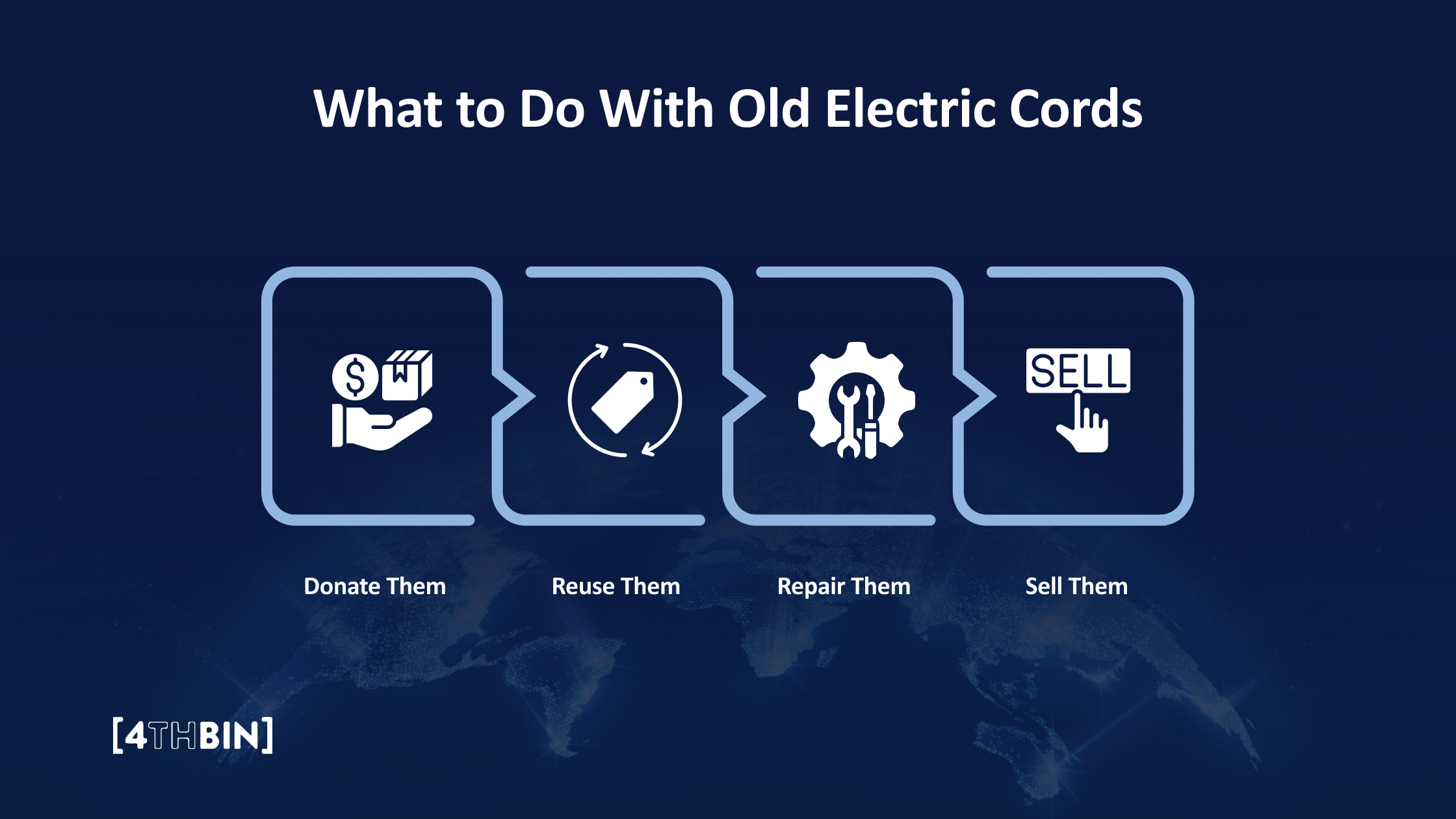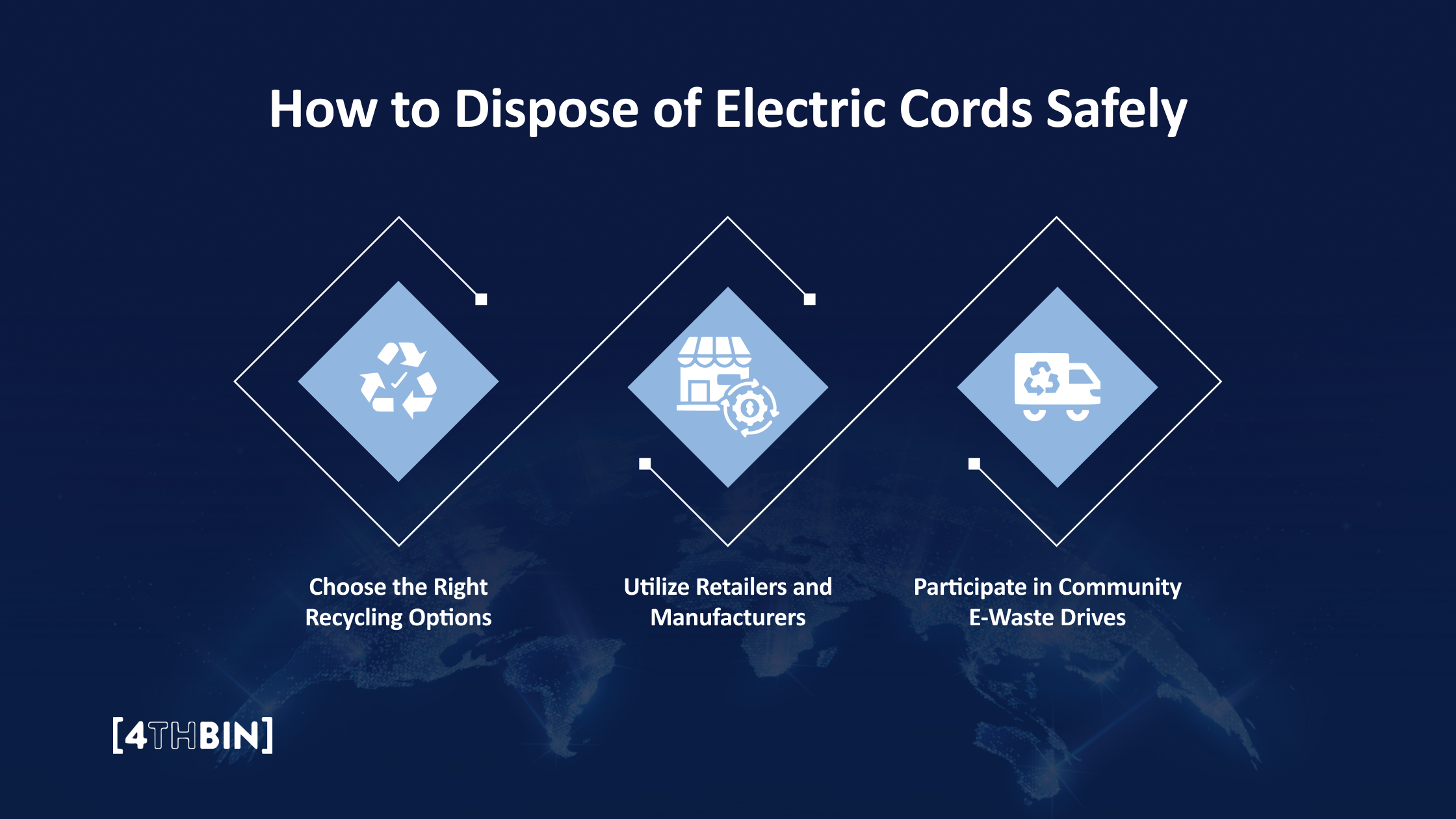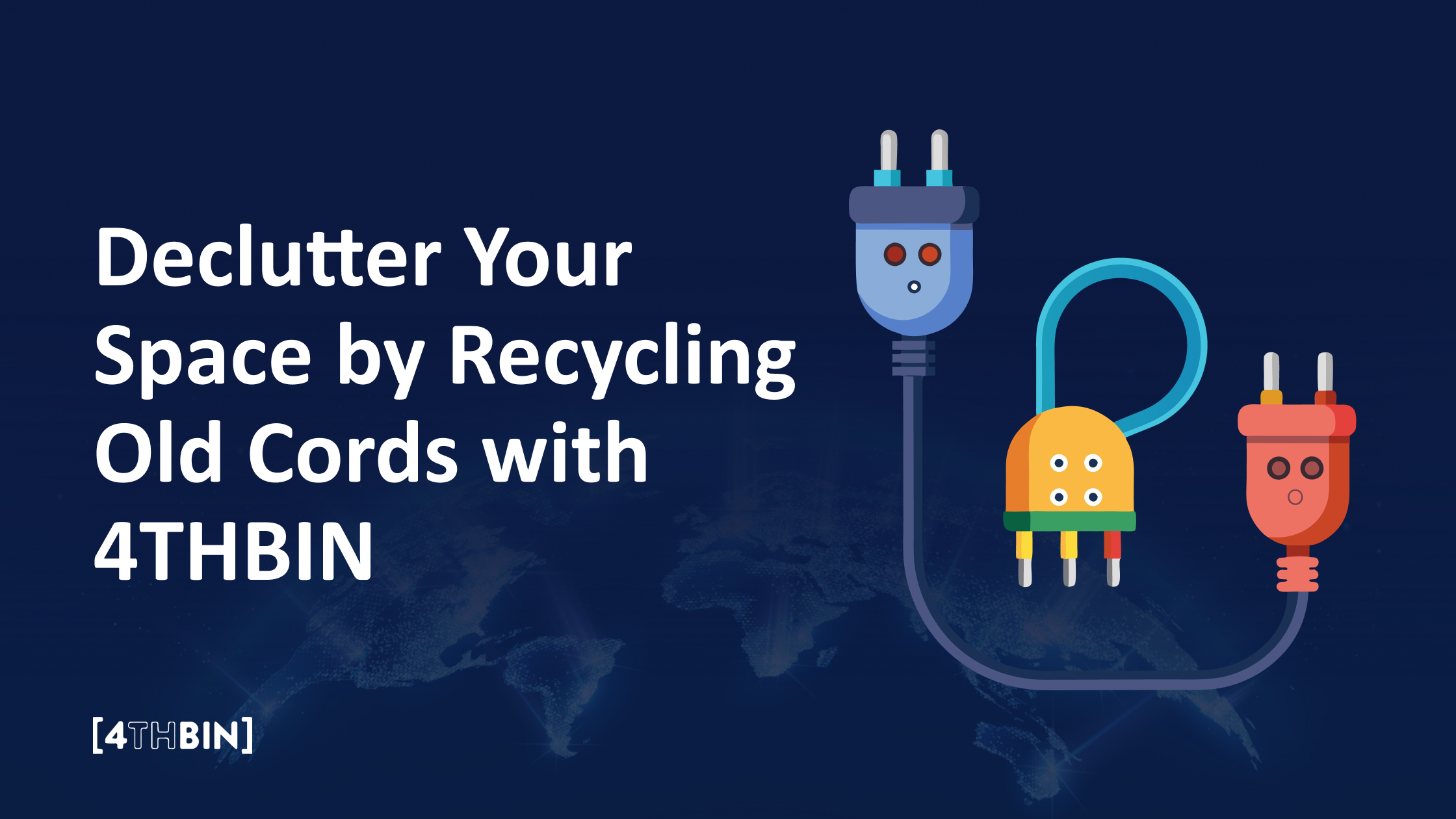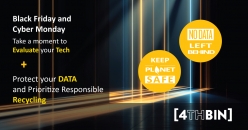How to Responsibly Recycle Your Old Electrical Cords?
Can you imagine going a whole day without your phone? Even worse, what if you had no phone or laptop charger? It’s hard to picture surviving that, isn’t it? From charging your phone to running your favorite gadgets, they quietly keep everything plugged in and powered up. But what happens when their time is up?
Look around your home. Chances are, you’ll find a drawer stuffed with outdated chargers, frayed cables, and cords you no longer recognize. These overlooked items tell a story of a growing e-waste crisis. Tossing them in the trash might feel like a small act, but it has consequences, such as wasted resources, environmental harm, and missed opportunities to recycle valuable materials.
Yet, about 950 million cables were discarded in landfills, enough to circle our planet 107 times, contributing to a global e-waste crisis spiraling out of control.
This blog will explore when to let go of old cords, how to prepare them for recycling, and where to take them to ensure they’re disposed of responsibly. It’s time to clear out that drawer, recover what’s valuable, and make a lasting impact on the environment.
When to Dispose of Your Electric Cords
Knowing when to dispose of your electric cords ensures safety, functionality, and proper resource management. Here are some signs to look out for:
Visible Damage
Inspect your cords regularly for signs of physical damage.
- The cord poses a significant safety risk if the protective insulation is damaged and wires are exposed.
- Overheating can cause visible burn marks or melting, indicating the cord is unsafe for further use.
- Damaged plugs, USB tips, or other connectors can make the cord unreliable or unusable.
If you notice any of these issues, it’s time to stop using the cord and consider repairing or recycling it.
Malfunctioning Performance
Electric cords that no longer function as expected are candidates for disposal. If the cord fails to deliver a steady connection, it may have internal damage or wear. For USB or charger cables, unreliable performance often means the internal wiring is compromised. Testing the cord with multiple devices can confirm whether the issue lies with the cord itself or the device.
Outdated Technology
With technology advancing rapidly, cords developed for older devices may no longer be compatible with newer models. Cords with outdated connectors, like mini-USB or specific proprietary formats, may no longer be applicable. Older cords may become unnecessary if you’ve upgraded to wireless solutions or consolidated devices. Instead of letting them clutter your home, dispose of outdated cords responsibly by recycling or donating them.
Overheating
If your cord becomes unusually hot during use, it could indicate a short circuit or internal fault. Overheating is a safety hazard that can lead to fires or damage to connected devices. In such cases, it’s best to stop using the cord immediately and dispose of it properly.
Excessive Damage
Cords frequently bent, coiled, or subjected to heavy use may develop internal damage even if the exterior looks intact. Over time, this wear can lead to performance issues or safety risks. If a cord has been in heavy use for several years, it might be time to replace and recycle it.
You can determine when to part ways with your electric cords by looking out for these signs. Remember, when disposal is necessary, always choose responsible recycling options to minimize environmental impact and recover valuable materials.
Why You Can’t Throw Electric Cords in the Trash
Although throwing electric cords in the trash might seem convenient, it poses serious environmental, safety, and legal risks. These cords contain non-biodegradable materials like plastics and metals, which can leach harmful chemicals into soil and water over time, contaminating ecosystems.
Valuable resources like copper and aluminum are also wasted when cords aren’t recycled, increasing the demand for mining and depleting finite materials.
Additionally, damaged cords in landfills can spark and ignite fires under high pressure or heat. Many regions have strict e-waste regulations, making it illegal to discard cords with regular trash, with penalties for non-compliance. Proper recycling protects the environment and ensures valuable materials are recovered and reused.
How to Identify Which Electric Cords Can Be Recycled?
Not all electric cords are destined for the landfill. Many contain valuable materials that can be recycled and reused, making proper disposal essential for reducing electronic waste. To begin with, it’s important to identify which types of electric cords can be recycled and what materials they contain.
What Are Electric Cords Made of?
Electric cords may seem like simple everyday items, but they are made of several intricate materials that make them functional and recyclable. Understanding their composition helps you better appreciate why proper disposal is essential and how these materials can be repurposed.
Conductive Core
At the center of every electric cord is a conductive core made of metal, typically copper or aluminum. Copper is the most common choice due to its excellent electrical conductivity and durability. While lighter and less expensive, aluminum is an alternative in some cords and has similar conductive properties. Both metals are highly recyclable, with copper repurposed for electrical wiring, industrial machinery, and countless other applications.
Insulation
Surrounding the conductive core is a layer of insulation designed to prevent electrical currents from escaping and to protect users from electric shocks. This insulation is typically made of plastic materials such as PVC (polyvinyl chloride) or polyethylene. These plastics are recyclable and can be processed into new products, reducing the need for virgin plastic production.
Outer Sheath
Most cords include an outer protective sheath, which provides additional durability and flexibility. This sheath, commonly made of plastic or rubber, shields the inner components from damage caused by bending, moisture, or wear and tear. Rubber sheaths can sometimes be repurposed alongside plastic ones, depending on the recycling facility.
Connectors
The connectors at the ends of cords—such as USB tips, plugs, or prongs—are often made of metal alloys or plated with materials like gold or nickel to enhance conductivity. These small but valuable components can also be recycled to recover their metal content, contributing to resource conservation.
Types of Electric Cords Suitable for Recycling
Electric cords come in many forms, and most can be recycled as long as they don’t contain hazardous materials. Here are some common examples:
- Extension cords: Often used in households, these cords typically contain copper wiring, which is highly recyclable.
- Power cables: These include cords that connect computers, televisions, and other appliances to power sources. They are also recyclable, especially if they are stripped of connectors.
- USB cables: Frequently used for charging devices and data transfer, USB cables are made from recyclable components like copper and plastic.
- HDMI, Ethernet, and AV cables: Though less common, these cords can be recycled for their metal wiring and plastic or rubber insulation.
- Chargers: Be it for a phone, laptop, or other electronic device, chargers are typically recyclable due to their copper content.
When recycling cords, checking with your local recycling facility to confirm what they accept is crucial. Some facilities may require cords to be stripped of non-recyclable components, such as rubberized coatings or connectors.
What to Do With Old Electric Cords

If you’ve found a drawer full of old electric cords and cables, don’t rush to toss them out. Here are a few ways to handle your old electric cords responsibly:
Donate Them
Your old cords might not be useful anymore, but they can be invaluable to others. Schools, community centers, and nonprofits often rely on donated items to meet their needs. Many of these organizations use electronics that require specific cables, and your unused cords could help them keep their devices running.
You might also consider donating to organizations that refurbish old electronics. These groups often pair functional cords with devices and distribute them to families, students, or individuals who can’t afford to buy new equipment. Check with local donation drives, thrift stores, or charities in your area to see if they accept cords. When donating, ensure the cords are clean and untangled to make them easier to handle and distribute. You can also label them to let the buyer know what they are used for.
Reuse Them
Reusing cords is a simple way to extend their life and avoid unnecessarily discarding functional items. Many old cords still work perfectly and can serve as spares or backups. Keep a few extras in your home or workplace for situations where you might need a replacement or an additional connection. For instance, extra USB cables can be useful for charging devices in different rooms, while power cords come in handy for appliances or tools that require a specific type of plug.
Reusing also applies to consolidating and organizing your electronics. If you have several devices that use similar cords, rotate them to ensure they all stay in good condition. Extending your cords' life through reuse reduces waste and saves money by avoiding unnecessary purchases.
Repair Them
Don’t assume a damaged cord is meant to be trashed. Many issues, like frayed wires or loose connections, can be fixed with basic tools or repair kits. Electrical tape can provide a quick and effective solution for minor damage by securing exposed wires and preventing further wear. Protective sleeves are another option, particularly for cords that experience frequent bending.
For complex issues like broken connectors or internal wiring, replacement parts and tutorials are available online. If you're uncomfortable repairing cords yourself, consider visiting a local electronics repair shop. These professionals can often fix cords at a fraction of the cost of buying new ones, and you’ll be doing your part to reduce waste.
Sell Them
Old cords, especially those in good condition, can have surprising value. Many people look for specific cables online, particularly for older or discontinued electronics. Selling your cords can be a great way to declutter while earning extra cash. Platforms like eBay, Craigslist, and Facebook Marketplace are ideal for listing individual cords or bundles.
Tech-savvy buyers are often willing to pay for cords they need to complete their setups. Vintage cables, specialty adapters, or chargers for discontinued devices can sometimes fetch higher prices than expected. If selling feels like a lot of effort, trading cords through local community groups or tech forums can also be an option. Many people are happy to swap items to get what they need.
How to Dispose of Electric Cords Safely
Electric cords might seem like small, inconsequential items, but they can have a significant environmental impact if not disposed of responsibly. Here’s how to ensure electric cords are disposed of safely and recycled effectively:
Choose the Right Recycling Options
Finding e-waste recycling facilities or programs that accept electric cords is the first step in disposing of them. These outlets specialize in safely processing cords to recover valuable materials like copper, plastic, and aluminum while ensuring that non-recyclable elements are handled responsibly.
Many local recycling centers and municipal recycling programs now accept electric cords as part of their e-waste initiatives. Check with your city or town’s waste management department to locate a nearby center. Some centers may have specific guidelines, such as separating cords by type or removing connectors, so confirming the requirements is essential before dropping off your cords.
Specialized e-waste recycling programs handle electric cords, cables, and chargers. These facilities use innovative recycling technologies to separate valuable materials, such as copper and aluminum, from the cords, which can be repurposed for new products.
To ensure the highest environmental and ethical standards, opt for certified e-waste recyclers, such as those with R2v3 (Responsible Recycling) certification. These certified services follow strict guidelines for data security, material recovery, and environmentally responsible recycling practices.
Moreover, E-waste programs often operate on a larger scale and may offer additional drop-off or pick-up services.
Utilize Retailers and Manufacturers
Retailers and manufacturers play a significant role in making e-waste recycling accessible. Many have implemented take-back programs specifically for small electronics, including cords.
Electronics retailers like Best Buy and Staples often offer convenient, in-store e-waste recycling bins. These programs allow customers to drop off cords and cables for free or a nominal fee. This is an easy and reliable option for recycling cords, especially if you’re already shopping there.
Brands such as Apple, Dell, and HP have established recycling initiatives to take back their products, including cords and chargers. Many programs allow you to mail in your cords or drop them off at specific locations. Check the manufacturer’s website for details on how to participate.
Participate in Community E-Waste Drives
Local communities frequently organize e-waste collection events where you can drop off old cords alongside other electronics like laptops and phones. These events are usually seasonal or one-time efforts, making them an excellent opportunity to simultaneously clear out multiple electronic items. Monitor local announcements, community websites, or social media groups to stay informed about upcoming drives.
How to Prepare Electric Cords for Recycling
Properly preparing your electric cords for recycling makes the process more efficient for recycling facilities. Here is how you can prepare:
- Clean and Inspect Cords: Wipe down cords to remove dirt, dust, or residue. This ensures they’re clean and ready for processing. Inspect cords for damage. If they’re still functional, consider donating or reusing them instead of recycling them.
- Untangle and Organize: Untangle cords to make them easier to handle. Jumbled wires can slow down processing at recycling facilities. Group similar types of cords together, such as USB cables, power cords, or extension cords, to simplify sorting.
- Remove Non-Recyclable Parts: Detach non-recyclable components, such as rubber straps, zip ties, or connectors. Some recycling facilities may not process these parts. Check if your local facility accepts cords with adapters or bulky connectors or if they need to be handled separately.
- Bundle Cords Neatly: Coil cords individually and secure them with a twist tie or rubber band. This prevents them from getting tangled during transport or at the recycling facility. Group cords together in labeled bags or boxes for larger quantities, indicating the type of cords inside.
Recycling electric cords responsibly requires effort, but the impact is worth it. Every step you take contributes to reducing e-waste and preserving the environment for future generations!
Declutter Your Space by Recycling Old Cords with 4THBIN
Are you worried your old electric cords take up unnecessary space in your drawers? With 4THBIN ’s e-recycling solutions, you can ensure secure, compliant, and environmentally responsible disposal of old chargers and cables.
With over a decade of experience, 4THBIN has partnered with more than 10,000 organizations, including Fortune 100 companies and small businesses, to transform e-waste challenges into opportunities.
Our certified data destruction services ensure that sensitive information is completely safeguarded, eliminating the risks of data recovery associated with improper disposal. From secure RemoteReturn mail-in options to convenient on-site collection, our customizable solutions allow you to choose the plan that best suits your needs.
Don’t let old cables collect dust.
Contact Us












